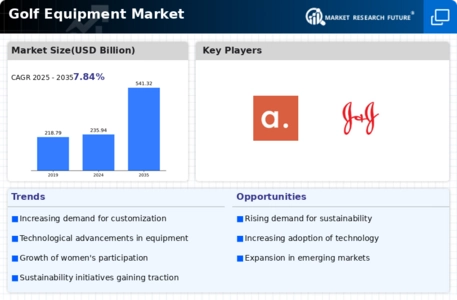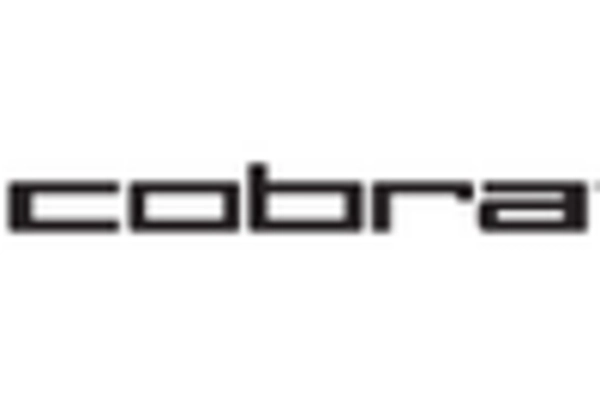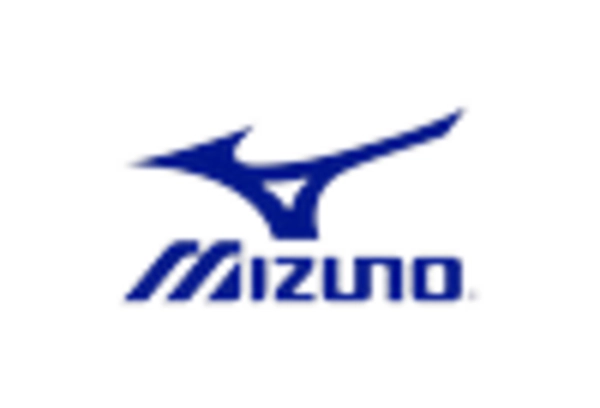Health and Wellness Trends
The increasing focus on health and wellness is significantly influencing the Golf Equipment Market. As more individuals seek outdoor activities that promote physical fitness, golf has emerged as a popular choice. The sport offers a low-impact exercise option that appeals to a wide range of age groups. In recent years, participation rates in golf have shown a steady increase, with millions of players worldwide. This trend is expected to continue, as golf is often associated with a healthy lifestyle. Consequently, the demand for golf equipment, including clubs, balls, and apparel, is likely to rise. The Golf Equipment Market stands to benefit from this growing awareness of health and fitness, as more people take up the sport to enhance their well-being.
Sustainability Initiatives
Sustainability initiatives are becoming increasingly prominent within the Golf Equipment Market. As environmental concerns grow, manufacturers are responding by developing eco-friendly products. This includes using sustainable materials in the production of golf clubs and balls, as well as implementing recycling programs. The market for sustainable golf equipment is projected to expand, as consumers become more conscious of their environmental impact. In 2025, it is estimated that the demand for eco-friendly golf products could account for a significant portion of overall sales. This shift towards sustainability not only aligns with consumer values but also enhances brand loyalty. The Golf Equipment Market is likely to see a positive response from environmentally aware consumers, driving growth in this segment.
Technological Advancements
The Golf Equipment Market is experiencing a notable transformation due to rapid technological advancements. Innovations such as smart golf clubs and GPS-enabled devices are enhancing the playing experience. These technologies not only improve performance but also attract a younger demographic, which is crucial for the industry's growth. In 2025, the market for smart golf equipment is projected to reach approximately 1.5 billion dollars, indicating a robust demand for high-tech solutions. Furthermore, the integration of data analytics in golf equipment allows players to track their performance more effectively, thereby increasing engagement and participation in the sport. As technology continues to evolve, it is likely that the Golf Equipment Market will see further growth driven by these advancements.
Global Events and Tournaments
The Golf Equipment Market is significantly influenced by the occurrence of major global events and tournaments. High-profile competitions, such as the Masters and the Open Championship, generate substantial interest in the sport. These events not only showcase top talent but also inspire fans to take up golf, leading to increased sales of equipment. In 2025, it is anticipated that the excitement surrounding these tournaments will drive a spike in demand for golf gear, as enthusiasts seek to emulate their favorite players. Furthermore, sponsorships and partnerships with professional golfers can enhance brand visibility and credibility, further stimulating market growth. The Golf Equipment Market is likely to see a positive impact from these events, as they create a vibrant atmosphere that encourages participation and investment in golf.
Increased Participation in Golf
The Golf Equipment Market is benefiting from a surge in participation rates across various demographics. Initiatives aimed at making golf more accessible, such as affordable equipment and community programs, are attracting new players. In recent years, the number of golf courses and driving ranges has increased, providing more opportunities for individuals to engage with the sport. This rise in participation is expected to drive demand for golf equipment, as new players seek quality products to enhance their experience. Additionally, the introduction of programs targeting youth and women is likely to further diversify the player base. As participation continues to grow, the Golf Equipment Market is poised for expansion, with increased sales of clubs, balls, and accessories.

















Leave a Comment